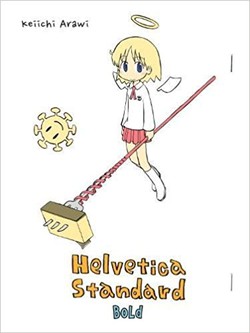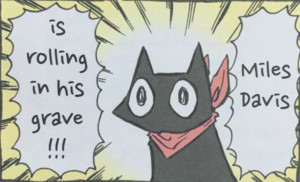The Fall 2017 Manga Guide
Helvetica Standard Bold
What's It About?

Helvetica Standard Bold presents both everyday and improbable scenarios in a series of four-panel comic strips. Showcasing familiar nichijou characters as well as original creations, Helvetica Standard Bold also features commentary from mangaka Keiichi Arawi, some of his sketches, and a brief collection of his personal essays. The most frequently-occurring characters include child professor Hakase, robot girl Nano, and talking cat Sakamoto.
Helvetica Standard Bold is a short collection of comic strips, doodles, and commentary by Keiichi Arawi that is considered a follow-up to his series nichijou. Published by Vertical Comics, the full-color volume is available in paperback for $16.95. The anime adaptation of nichijou includes Helvetica Standard interludes partially based on this series and is available on Blu-Ray from Funimation.
Is It Worth Reading?

Amy McNulty
Rating: 1.5
Adorably funny and often relatable, nichijou showcased Arawi's talents as a comedic storyteller. Helvetica Standard Bold is an addendum to Arawi's other manga and not that enjoyable on its own, despite the fact that not all of the strips are directly related to that series. Readers don't have to be intimately familiar with the characters to find the jokes funny—and some characters are original regardless—but the jokes are hit-or-miss, largely because so many of them are just advertisements for the latest nichijou manga volume release in Japan. Arawi tries to make the little promotions humorous, but they're not as funny as the standalone strips and they get tiresome to read one after another. Admittedly, they weren't created to be read all at once, but presented as nearly half the volume here, the repetitive theme of “the latest volume came out!” gets old fast. However, the commentary Arawi provides elicits a chuckle at least half the time and his essays about weird moments in his life as a child and a young man are surrealistic and funny, though the drawings he offers to go along with them are too small to complement the stories well.Arawi's art is far and away the best part of this volume. Adorable and full of soft lines, the character designs make the comedy even more effective. Backgrounds are minimal to non-existent but aren't necessary in a collection of set-up, set-up, punchlines. Presenting the strips in full color elevates the entire book another half star; the bright colors make each comedic moment pop off the page and lend additional warmth to an already-cozy atmosphere.
Devoted nichijou fans will want to get their hands on this collection, if only for the artwork and a few bonus jokes. Although the comedy may not be to the level that it is in nichijou, enthusiasts of Arawi's work will welcome as much time with these silly characters as possible regardless. On the other hand, anyone new to the series should bypass Helvetica Standard Bold until they've read nichijou; it's not that accessible to fans unfamiliar with the other series and it's nowhere near representative of Arawi's best work.
 Lynzee Loveridge
Lynzee LoveridgeRating: (for the Nichijou uninitiated)
I'm familiar with Keiichi Arawi as the creator of Nichijou and I'm familiar with Nichijou as the anime where a guy suplexes a deer. Outside of that one particular gif image, I am uninitiated into the comical mind of Arawi, and unfortunately Helvetica Standard Bold is not a friendly way to start. The volume is less of a manga collection in its own right as it is supplementary material from the creation of Nichijou. It can be broken up roughly into three parts: approximately 40 strips that were run in Newtype magazine that bear no relation to Arawi's previous works, another third that one-off strips from the Nichijou world that ran as promotions for the comic proper, and the last third are some anecdotal short stories and color illustrations. The comics in the second third are similar to the sometimes comical author-talk strips you find at the back of collected manga volumes but seem to expect familiarity with the Nichijou cast.
This was a hurdle for me and I expect anyone else who hasn't already picked up Vertical's release of Nichijou. The short format doesn't give any room for readers to get their bearings on who's who before the punchline, so plenty of the second section falls flat without that prior familiarity. At least, I presume that's why but the first section was also only okay in the humor department. The problem is two-fold: the humor's origin and in some cases what I suspect is failed adaptation. For example, one strip shows Santa arriving on Christmas Eve with a gift of “Kabuki Crackers” for a boy. He takes the bag, throws it against the wall with a smack, tears rolling down his cheeks as Santa looks at him in shock. I know there's a kabuki joke in there, but it's whizzing over my head. Another has one man ask another to say the word pizza 10 times before giving him an “worker visa alien employment permit.” The man responds in shock. I'm still trying to figure out this joke.
Most of the jokes were a miss and the best got an amused snort, but I'd be remiss not to mention the off-color transsexual bathroom joke included in the first half. Maybe it seemed witty when it was originally published, but having a woman be corrected before using a unisex bathroom by a masculine-framed person with pigtails and visible five-o-clock shadow is not only tired, but is bound to be ill-received in today's climate where people are finally paying attention.
This really wasn't the introduction to Arawi's comedy that I hoped for, as the strips range from incomprehensible to absurdly amusing but never particularly poignant or empathetic in the a way where the reader can relate to the comedy on the page.
 Austin Price
Austin PriceRating:
There's nothing as exciting in the pages of Helvetica Standard Bold as you might expect given its pedigree. Keeichi Arawi's Nichijou is one of the sharpest slice-of-life comedies in ages, after all, bursting with inventive visual gags and razor wit all married to an impeccable sense of timing. One could hope that a companion volume compiling not just assorted one-shot strips and Nichijou cast-offs but a handful of essays would offer more of the same, if not even a development.
Instead, Helvetic Standard Bold finds Arawi in a mode so playful it often slides into the unabashedly idiotic. There's no sly social satire lurking in a gag about a sparrow and tanuki who can't afford to pay rent because the former is a gambling addict and the latter a deadbeat, no melancholy emotional truth hiding in a strip about a man doubled over in anguish because he discovers that the Bugle chips he loved as a child will no longer fit on his fingers. Nor is there any long-delayed pay off on these, no clever threading between bits: the strips come back-to-back at a relentless pace and with a style that relies entirely on charm to get by. You'll see the punchlines coming a mile away except in moment of anti-comedy so blasé you can't tell if they're inspired or utterly moronic.
One or two instances of experimentation make it clear Arawi has by no means lost his talent for warping conventions of form – there's a fantastic bit about a dog chasing a shot-put it mistaked for a Frisbee put that finds Arawi using the blank area between panels and pages to create a wonderful sense of space. And their style remains undeniably warm. But most of these just feel like a comedian limbering up in his spare time, staying antic to insure that he doesn't ossify by habit and boredom.
The result is a collection that's simply uneven. For every brilliant strip there are two unremarkable ones and one bad one; even amongst these only a few stand out in any meaningful way. The essays in the back don't showcase an untapped element of Arawi's talent or sensibilities. They simply feel like oversketched outlines to gags he might one day bother getting down in 4-panel form.
By far the most interesting element of this cabinet of curiosities are the illustrations at its back. No longer constrained by the cramped confines and straightjacketing of timing the typical strip demands, Arawi finally has a chance to show off an eye for detailed world building and talent for creating believable, lived-in environments as full of personality as his characters. There aren't many of these, but each of them provides so fully realized a little pocket of the world they're easy to get lost in.
Helvetic is less an essential follow-up to Arawi's masterpiece than a companion piece packed with esoterica. That's not a clear condemnation: there is worthy material here. But it is a warning. As amusing as this volume is, it offers little to the fan of comedy or Arawi that they need to see. Nobody quibbling over whether to get it should feel guilt for passing on by.
 Rebecca Silverman
Rebecca SilvermanRating:
If you're a major fan of nichijou, this slim, full-color volume is much more likely to be of interest. Otherwise, there really isn't a whole lot here to recommend the collection of four-panel absurdist strips, nichijou advertisements, and random stories and illustrations. It is cute, but not much beyond that.
That isn't to say that there's nothing enjoyable here. Arawi's prose stories recounting episodes from his life ages 10 – 18 are the kind of goofy relatable that makes you understand where he got the idea for nichijou in the first place – there may not be any robotic girls or talking cats, but there's no surfeit of weird friends and normal-yet-bizarre antics. (I do hope the story about the teacher slapping them is exaggerated, though.) From the perils of lost homework to the torment of sandwiches that stick in your throat, this section is very human.
The weakest is probably the one most closely related to Arawi's signature work. The nichijou section is entirely composed of four-panel strips wherein the characters announce the release of a new volume or the anime adaptation. They're cute, but I don't feel like we'd have lost anything by not having them released in English. Some of the standalone illustrations, on the other hand, are very nice, and it's good to know that Arawi uses watercolors rather than digitally paining, if only as a point of interest. The map of his studio is also fun, though it certainly looks like a very claustrophobic workspace.
If you're a completist, Helvetica Standard will round out your nichijou collection. Otherwise this could probably be left on the shelf, because there's really nothing to it as a book.
discuss this in the forum (49 posts) |
this article has been modified since it was originally posted; see change history
back to The Fall 2017 Manga Guide
Feature homepage / archives